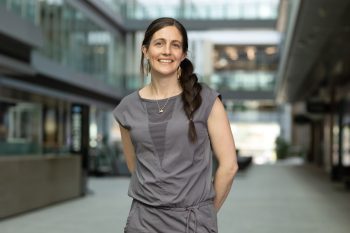A new study has linked the stiffness of breast tissue to the progression of a particularly aggressive form of breast cancer.
Published in Nature Medicine this month, the study may help clinicians differentiate between aggressive forms of the disease, which tend to have a poor prognosis, and less deadly forms. University of Toronto Assistant Professor Penney Gilbert, a core faculty member at the University of Toronto’s Institute of Biomaterials & Biomedical Engineering and the Donnelly Centre for Cellular & Biomolecular Research, was involved in the two studies that led to this discovery.
Back in 2010, Gilbert and fellow researchers in Professor Valerie Weaver’s laboratory at the University of California San Francisco (UCSF) discovered a vital link between the presence of a particular protein, HOXA9, and production of the BRCA1 protein. When mutated, the BRCA1 protein malfunctions, and it can trigger particularly deadly forms of breast cancer.
“BRCA1 mutation is one of a handful of known heritable genetic mutations that greatly increase the risk of developing breast cancer,” said Professor Gilbert. “In recent news, when Angelina Jolie learned that she was a carrier of this mutation, she underwent a double mastectomy as a preventative measure to ward off the aggressive breast cancer.”
The researchers, though, found that HOXA9 plays a vital role in the suppression of the disease.
“HOXA9 makes more BRCA1, which [in its non-mutated state] is a tumour suppressor,” Professor Gilbert explained, “and that allowed us to understand why a population of women who didn’t have BRCA1 mutation could have breast tumours that very much resembled those with a BRCA1 mutation. Low levels of HOXA9 were most commonly observed in these types of breast tumours.”
The study concluded that low HOXA9 levels correlated with higher likelihood of metastasis as well as a significantly higher incidence of relapse.
“So the question is,” added Professor Gilbert, “why do they lose HOXA9 expression?”
As it turns out, the mechanical properties of the tissue environment – in particular, its stiffness – may play a major role in the progression of the disease.
Following the 2010 study, Gilbert worked together with Janna Mouw, an associate specialist in the Weaver lab and first author of the Nature Medicine study, to show that HOXA9 protein expression – the protein that leads to tumour suppressing BRCA1 expression – was lost in stiff tissue environments.
“A specific microRNA (miR-18a) – which is neither a protein nor a hormone, but another type of small molecule – appears to dial down the levels of several breast tumour suppressors, including HOXA9,” said Professor Gilbert. This ‘dialing down’ in turn blocks production of BRCA1.
The findings are of particular clinical interest, as they may lead to quicker identification of the difficult-to-treat and aggressive breast cancer subtypes.
“This discovery of the molecular chain of events between tissue stiffening and breast cancer progression may lead to new and more effective treatment strategies that target structural changes in breast cancers and other tumours,” said Valerie Weaver, professor of surgery and director of UCSF’s Center for Bioengineering and Tissue Regeneration.
“Our study indicates that it isn’t enough to treat the genetic defects,” Professor Gilbert argued. “We need to look at how to return the environment surrounding the tumour to its normal softness. It’s important for us to consider both the genetic and the biomechanical aspects of tumour initiation.”



